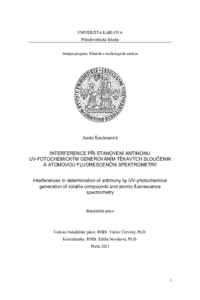Interference při stanovení antimonu UV-fotochemickým generováním těkavých sloučenin a atomovou fluorescenční spektrometrií
Interferences in determination of antimony by UV-photochemical generation of volatile compounds and atomic fluorescence spectrometry
bachelor thesis (DEFENDED)

View/
Permanent link
http://hdl.handle.net/20.500.11956/151002Identifiers
Study Information System: 228735
Collections
- Kvalifikační práce [20356]
Author
Advisor
Consultant
Nováková, Eliška
Referee
Hraníček, Jakub
Faculty / Institute
Faculty of Science
Discipline
Clinical and Toxicological Analysis
Department
Department of Analytical Chemistry
Date of defense
13. 9. 2021
Publisher
Univerzita Karlova, Přírodovědecká fakultaLanguage
Czech
Grade
Excellent
Keywords (Czech)
interference, antimon, atomová fluorescenční spektrometrie, UV-fotochemické generování těkavých sloučeninKeywords (English)
iterferences, antimony, atomic fluorescence spectrometry, UV-photochemical generation of volatile compoundsTato práce je zaměřena na studium interferentů vybraných prvků při UV - fotochemickém generování těkavých sloučenin antimonu. Mezi interferenty byly zařazeny přechodné kovy, halogenidy, hydridotvorné prvky a soli minerálních kyselin. Detekce byla prováděna pomocí atomové fluorescenční spektrometrie. Některé z testovaných přidaných látek se ukázaly být potenciálními modifikátory reakce; v jejich přítomnosti bylo pozorováno zvýšení odezev. Nejlepších výsledků pro zvýšení účinnosti generování bylo dosaženo s použitím Fe3+ pro stanovení Sb3+ a pro stanovení Sb5+ měl nejlepší výsledky SO4 2- . Největším interferentem, tedy látkou způsobující nejvýznamnější pokles signálu, byl pro oba ionty antimonu Se4+ .
This work is focused on the study of interferents of selected elements during UV-photochemical generation of volatile antimony compounds. The interferents included transition metals, halides, hydride-forming elements and salts of mineral acids. Detection was performed by atomic fluorescence spectrometry. Some of the tested added substances proved to be potential reaction modifiers; in their presence, an increase in responses was observed. The best results were obtained using Fe3+ for the determination of Sb3+ and SO4 2- had the best results for the determination of Sb5+ . The largest interferent, i.e. the substance causing the most significant decrease in signal, was for both antimony ions Se4+ .
